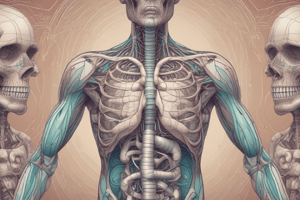Podcast
Questions and Answers
What is the function of the upper respiratory tract?
What is the function of the upper respiratory tract?
- To carry air to the lower respiratory tract (correct)
- To breathe in oxygen and breathe out carbon dioxide
- To direct air into the lungs
- To exchange oxygen and carbon dioxide
What is the primary function of the lungs?
What is the primary function of the lungs?
- To breathe in oxygen and breathe out carbon dioxide
- To allow gases to move in and out of the body (correct)
- To regulate body temperature
- To protect the body from foreign particles
What is the diaphragm?
What is the diaphragm?
- A bony shield of protection for the lungs
- A muscle that separates the chest cavity from the abdominal cavity (correct)
- A thin, broad muscle that sits above the lungs
- A pair of airways that direct air into the lungs
What happens to the diaphragm when you breathe in?
What happens to the diaphragm when you breathe in?
What are the airways called that direct air into the lungs?
What are the airways called that direct air into the lungs?
What is the function of the bronchioles?
What is the function of the bronchioles?
What is the waste gas given off by cells when they do work?
What is the waste gas given off by cells when they do work?
What happens to the diaphragm when you breathe out?
What happens to the diaphragm when you breathe out?
What is the name of the bony shield of protection for the lungs?
What is the name of the bony shield of protection for the lungs?
What is the purpose of the lower respiratory tract?
What is the purpose of the lower respiratory tract?
Flashcards are hidden until you start studying
Study Notes
The Respiratory Tract
- The respiratory system has two parts: the upper respiratory tract and the lower respiratory tract.
- The upper respiratory tract includes the nose, mouth, throat, larynx, and trachea, and carries air to the lower respiratory tract.
Lungs and Diaphragm
- The lungs are organs that allow gases to move in and out of the body.
- The lungs take up much of the space underneath the ribs, which act as a bony shield of protection.
- Even when empty, the lungs are not hollow like balloons, but rather resemble a porous sponge.
- The diaphragm is a thin, broad muscle that sits below the lungs and helps breathe oxygen-filled air into the lungs when it contracts.
- When the diaphragm relaxes, it pushes stale air out of the lungs.
Bronchi and Bronchioles
- Air enters the lungs through a pair of airways called bronchi (bronchial tubes).
- The bronchi divide into smaller airways called bronchioles inside the lungs.
- The bronchi and bronchioles spread out like a tree, with the thick bronchi resembling tree trunks and the multiple bronchioles resembling branches.
Alveoli
- The bronchioles branch into smaller and smaller twigs until they end in tiny air sacs called alveoli.
- Alveoli resemble a bunch of grapes covered in spider webs, with the spider webs being tiny blood vessels.
- Oxygen passes through the thin walls of the alveoli and into the bloodstream, while carbon dioxide moves out of the blood and into the alveoli.
Studying That Suits You
Use AI to generate personalized quizzes and flashcards to suit your learning preferences.



